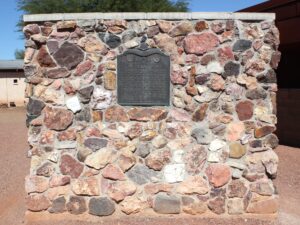Mormon Fort (Las Vegas Fort.)
las vegas, nv
Discription:
Large flagstone edifice with a metal plaque embedded into the front.
Responcible Organization/Individual:
State of Nevada Division of State Parks; State Historic Preservation Office.
Designed By:
Memorial by Daughters of Utah Pioneers; Fort renovation by assemblageSTUDIO.

Address:
500 E. Washington Avenue, Las Vegas.
GPS Coordinates:
Hours Available
Ceremonies: yes
History:
The memorial is situated inside the grounds of the Old Las Vegas Mormon Fort. In June of 1855, William Bringhurst and 29 fellow Mormon missionaries from Utah arrived at the site and began construction of a 150-foot square adobe fort, the first permanent structure erected in the valley. The area had been named by early Spaniard explorers — Las Vegas translating to The Meadows. The Mormon outpost, complete with a post office, served as a way station for travelers. The fort itself consisted of an adobe enclosure, with bastions on each side. The fort began as 150 feet square, walls 14 feet high, two feet wide at the base, and one for on top. After two years the outpost was abandoned due to a combination of dissension between leaders, and the hot summer temperatures. While called a fort, it was never home to any military troops but provided a defense for local settlers against Indian attacks. Around 1860, a small detachment of U.S. Army troops was assigned to protect the settlers at the fort, which they named Fort Baker during the Civil War, after Edward Dickinson Baker. In a letter from Col. James Henry Carleton written to Pacific Department headquarters, December 23, 1861, Carleton mentions a plan to send three cavalry companies and one of infantry to the Mormon fort at Las Vegas, and establish a post called Fort Baker. But presumably, the post was never garrisoned during the Civil War. In 1865 Octavius D. Gass bought the site and developed a ranch that included a store and a blacksmith shop. Ownership of the ranch later passed to Archibald and Helen Stewart. When Archibald was killed, Helen sold the ranch and water rights to the San Pedro, Los Angeles & Salt Lake Railroad. In 1905 the rails reached Las Vegas, and a new town sprang into existence. In 1929 the U.S. Bureau of Reclamation leased a building on the site of the fort as a testing lab during the construction of Hoover Dam. In 1989 the city of Las Vegas acquired the site. the Division of State Parks (with the Department of Conservation and Natural Resources) acquired the site in 1991 and began a major renovation protecting and preserving the site in keeping with the best historical and archeological data available. It was completed in 2005. The memorial itself was erected on Sept. 18, 1939. The fort is also designated as State Historical Marker No. 35, rededicated April 4, 2008, by the State Historic Preservation Office and National Society Daughters of the American Revolution.